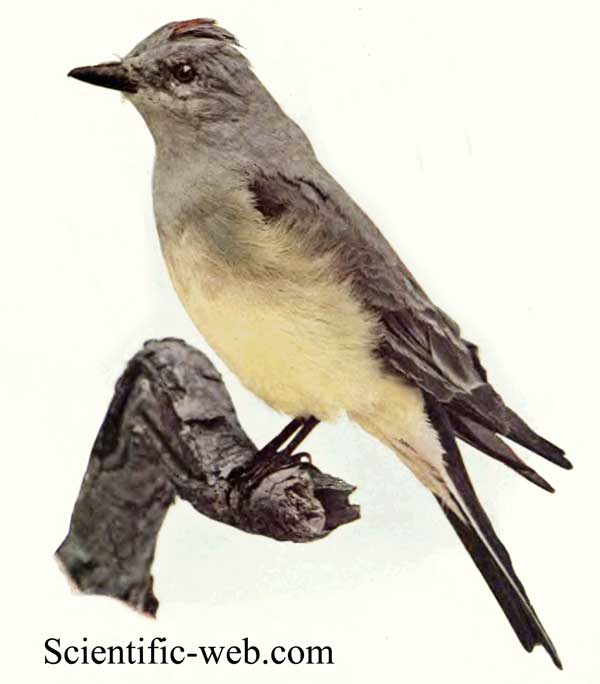
Tyrannus verticalis
Superregnum: Eukaryota
Regnum: Animalia
Subregnum: Eumetazoa
Cladus: Bilateria
Cladus: Nephrozoa
Superphylum: Deuterostomia
Phylum: Chordata
Cladus: Craniata
Subphylum: Vertebrata
Infraphylum: Gnathostomata
Superclassis: Tetrapoda
Cladus: Reptiliomorpha
Cladus: Amniota
Classis: Reptilia
Cladus: Eureptilia
Cladus: Romeriida
Subclassis: Diapsida
Cladus: Sauria
Infraclassis: Archosauromorpha
Cladus: Crurotarsi
Divisio: Archosauria
Subsectio: Ornithodira
Subtaxon: Dinosauromorpha
Cladus: Dinosauria
Ordo: Saurischia
Cladus: Theropoda
Cladus: Neotheropoda
Infraclassis: Aves
Ordo: Passeriformes
Subordo: Tyranni
Infraordo: Tyrannides
Parvordo: Tyrannida
Familia: Tyrannidae
Subfamilia: Tyranninae
Genus: Tyrannus
Species: Tyrannus verticalis
Name
Tyrannus verticalis Say, 1823
Type locality: near La Junta, Colorado, USA.
References
Say, T.. [Taxonomical footnotes]. In James, E.P. 1823. Account of an expedition from Pittsburgh to the Rocky Mountains, performed in the years 1819 and '20 : by order of the Hon. J.C. Calhoun, sec'y of war: under the command of Major Stephen H. Long. From the notes of Major Long, Mr. T. Say, and other gentlemen of the exploring party. H.C. Carey & I Lea. Philadelphia. 2: 1–442; i–xcviii. DOI: 10.5962/bhl.title.61116 Reference page. : p.60 footnote
Vernacular names
čeština: tyran západní
dansk: Vestlig Kongetyran
Deutsch: Arkansaskönigstyrann
English: Western Kingbird
español: Tirano occidental
eesti: lääne-türanntikat
suomi: niittytyranni
français: Tyran de l'Ouest
magyar: arkansasi tirannusz
italiano: Tiranno occidentale
日本語: ニシタイランチョウ, nishitairanchou
Nederlands: Arkansaskoningstiran
norsk: Vestkongetyrann
polski: tyran bahamski
português: Suiriri-ocidental
русский: Западный (королевский) тиранн
slovenčina: postriežkár čiernochvostý
svenska: Västlig kungstyrann
中文: 西王霸鹟
The Western Kingbird (Tyrannus verticalis) is a large tyrant flycatcher found throughout western environments of North America and as far as Mexico.
Adults are a combination of both gray and yellow plumage along with a crimson feathers that are hidden until courtship females or against intruders. Characteristic of other kingbirds, the western kingbird is very territorial, although the western is often misidentified with Cassin's Kingbird, Couch's kingbird, and the tropical kingbird due to the yellow coloration. The species can be distinguished among these species through its black squared tail with white outer lining.
in Nevada
Anatomy and Morphology
Standard Measurements[2][3]
length 8–9.3 in (200–240 mm)
weight 40 g (1.4 oz)
wingspan 15.5 in (390 mm)
wing 125.5–133.5 mm (4.94–5.26 in)
tail 88.5–96.5 mm (3.48–3.80 in)
culmen 20.5–22.5 mm (0.81–0.89 in)
tarsus 18.5–19.5 mm (0.73–0.77 in)
Distribution and Habitat
Their breeding habitat is open areas in western North America. The increase in trees throughout the Great Plains during the past century due to fire suppression and tree planting facilitated the range expansion of the western kingbird[4][5][6] as well as range expansions of many other species of birds.[7][8][9]
Behavior
The name kingbird is derived from their "take-charge" behavior. These birds aggressively defend their territory, even against much larger birds such as hawks. They will attack humans, livestock, and pets when they think their young are in danger. Kingbirds make a sturdy cup nest in a tree or shrub, sometimes on top of a pole or other man-made structure. Three to five eggs, white, creamy, or pinkish with heavy blotches of brown, black, or lavender, are laid and incubated for 12 to 14 days.[10]Due to the small size of the nest, and the chicks' rapid rate of growth, most of them are pushed out of the nest, due to overcrowding, before they are fully feathered and able to fly. [2]
These birds migrate in flocks to Florida and the Pacific coast of southern Mexico and Central America.
They wait on an open perch and fly out to catch insects such as bees, robber flies, winged ants, and grasshoppers, and spiders. They are also known to eat berries, buckthorn/sumac, and poison ivy seeds.[11]
Sound
The song is a squeaky chatter, sometimes compared to a squeaky toy. The call is a sharp loud whit. It occasionally sings before sunrise.
References
BirdLife International (2016). "Tyrannus verticalis". IUCN Red List of Threatened Species. 2016: e.T22700497A93780166. doi:10.2305/IUCN.UK.2016-3.RLTS.T22700497A93780166.en. Retrieved 13 November 2021.
Godfrey, W. Earl (1966). The Birds of Canada. Ottawa: National Museum of Canada. pp. 249–250.
Sibley, David Allen (2000). The Sibley Guide to Birds. New York: Knopf. pp. 336–337. ISBN 0-679-45122-6.
Ellis, E. and R. Kannan, 2004. The Western Kingbird (Tyrannus verticalis): a recently established breeding bird in Arkansas. J. Arkansas Academy Science 58: 52-59.
Houston S. 1979. The spread of the Western Kingbird across the prairies. Blue Jay 37:149–157.
Gamble LR, Bergin TM. 1996. Western Kingbird (Tyrannus verticalis), no. 227. In: A. Poole (ed.). The Birds of North America Online. Cornell Lab of Ornithology, Ithaca, New York
Livezey KB. 2009a. Range expansion of Barred Owls, part I: chronology and distribution. American Midland Naturalist 161:49–56.
Livezey KB. 2009b. Range expansion of Barred Owls, part 2: facilitating ecological changes. American Midland Naturalist 161:323–349.
Livezey KB. 2010. Killing barred owls to help spotted owls II: implications for many other range-expanding species. Northwestern Naturalist 91:251–270.
"Western Kingbird Life History, All About Birds, Cornell Lab of Ornithology".
"BioKIDS - Kids' Inquiry of Diverse Species, Welcome". www.biokids.umich.edu. Retrieved 2020-11-11.
Retrieved from "http://en.wikipedia.org/"
All text is available under the terms of the GNU Free Documentation License

